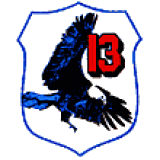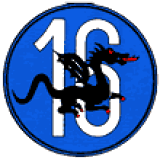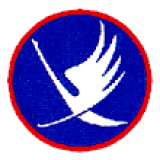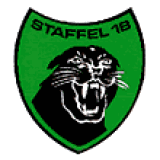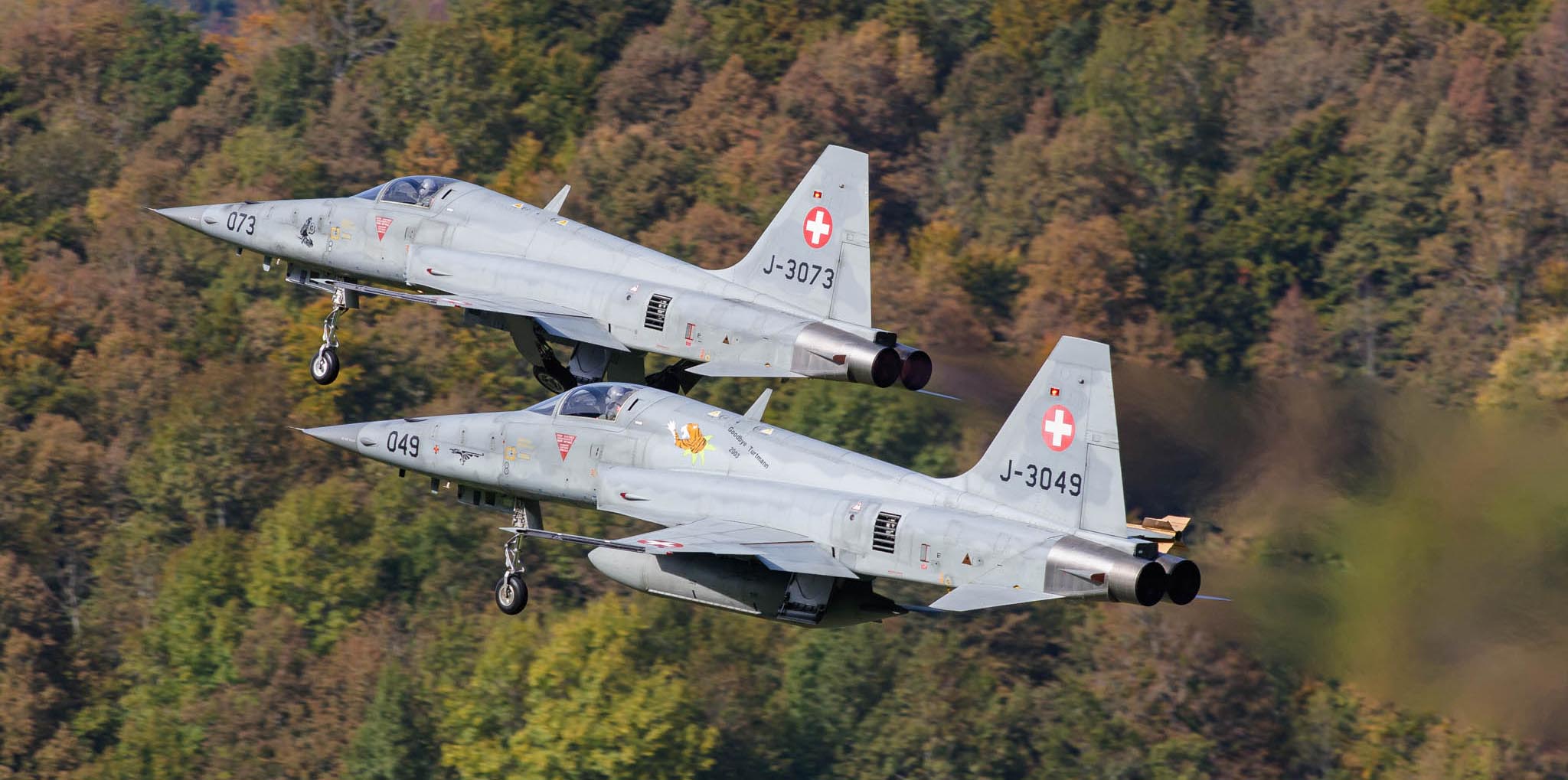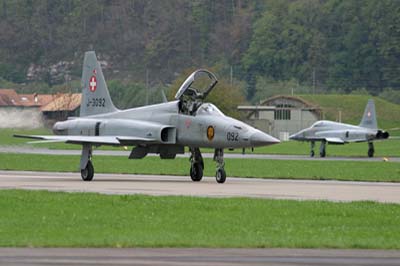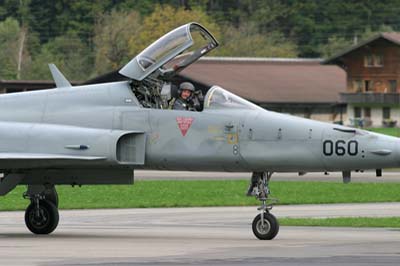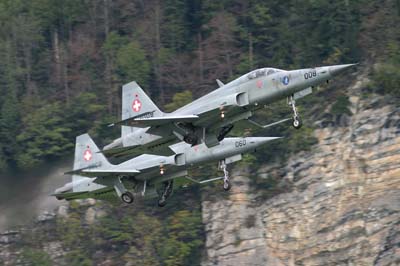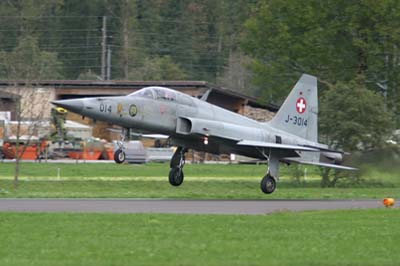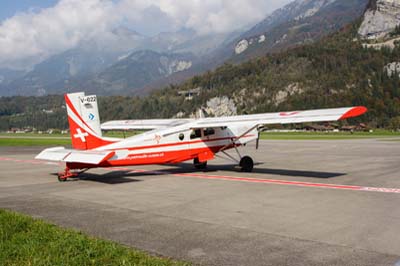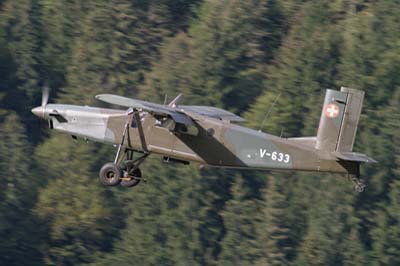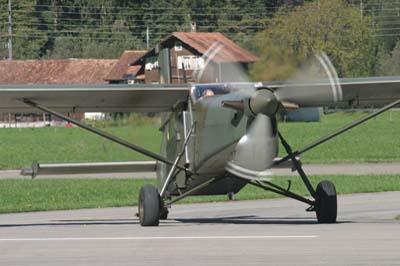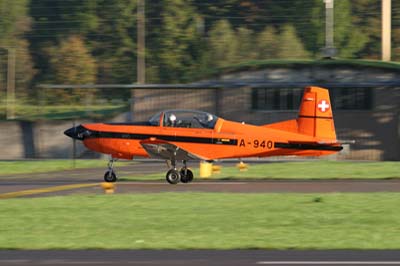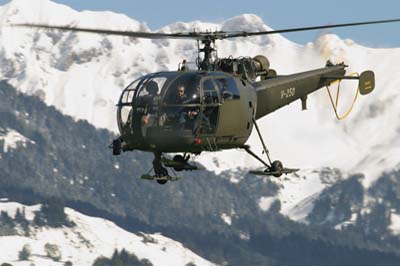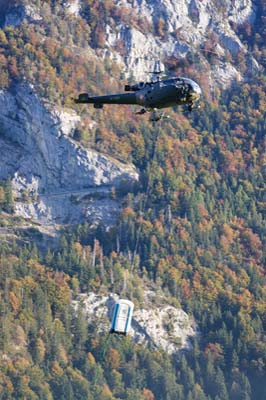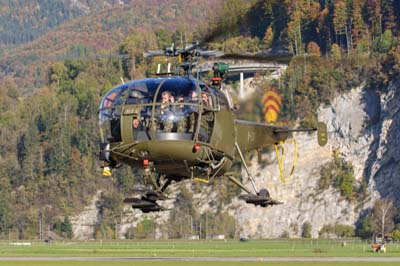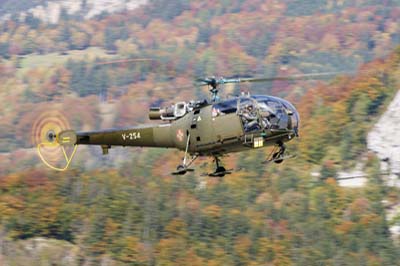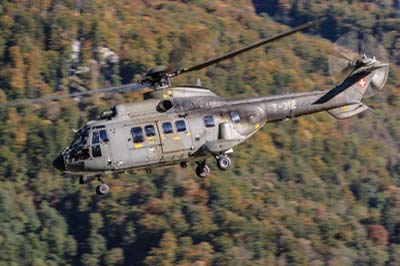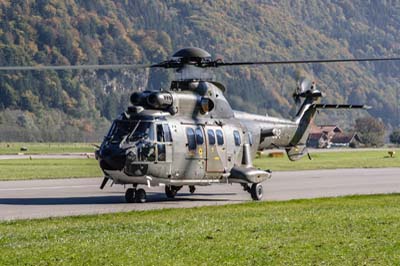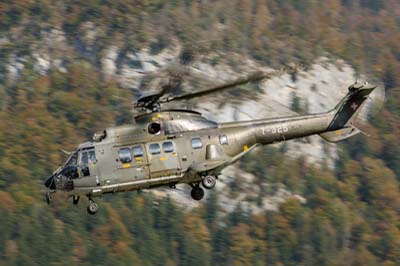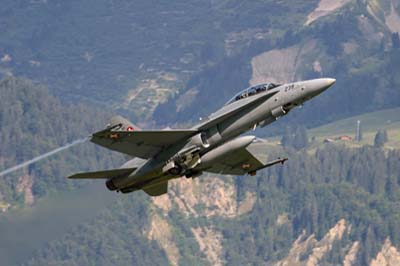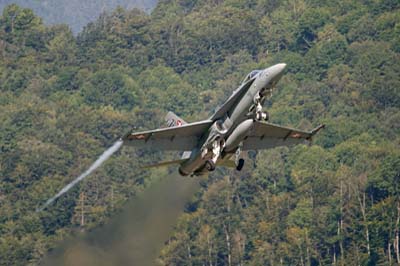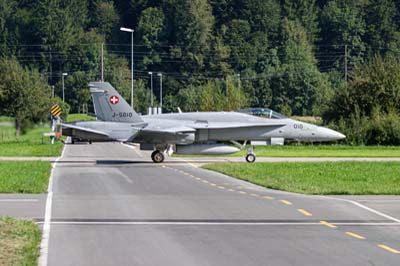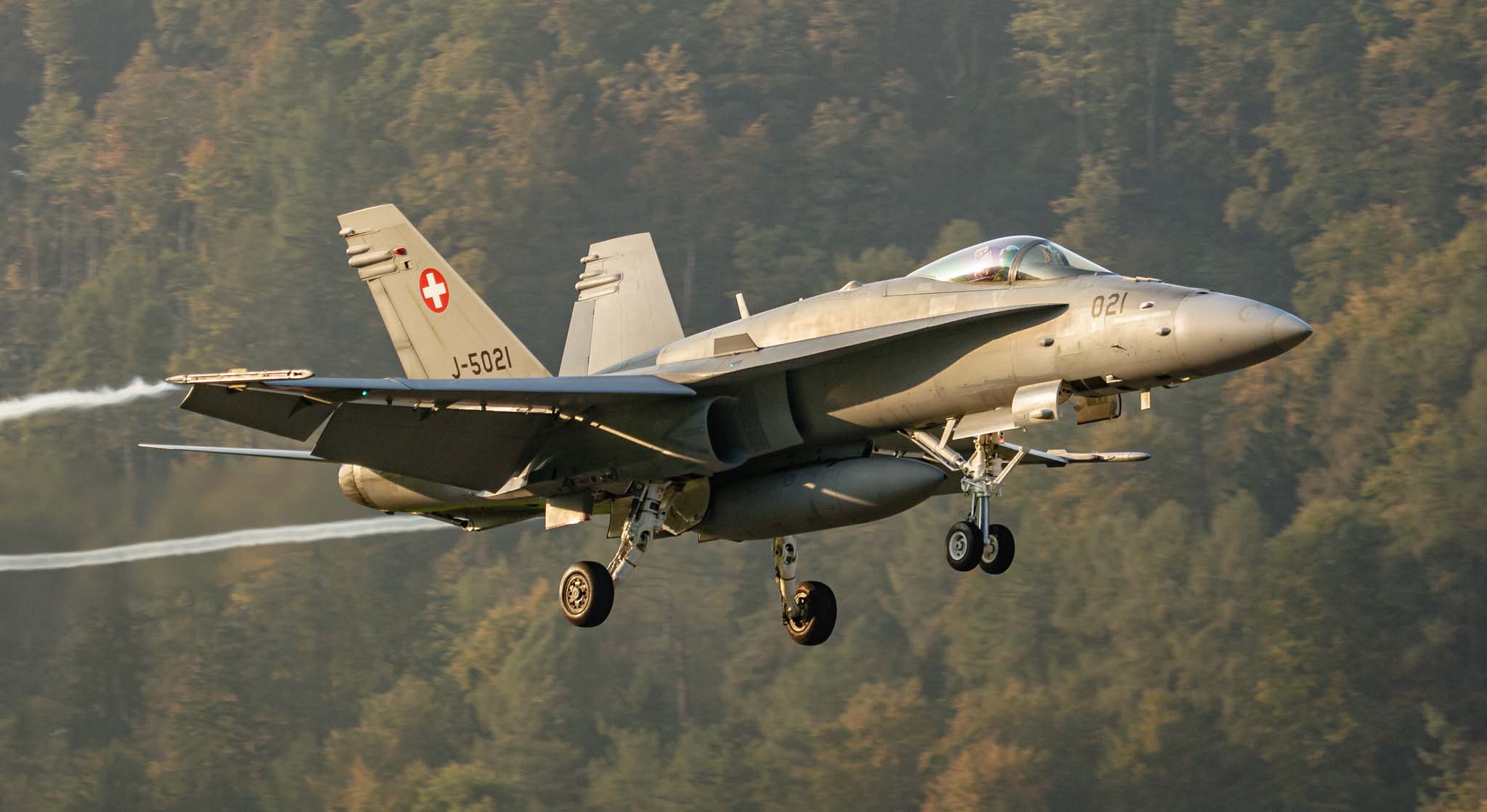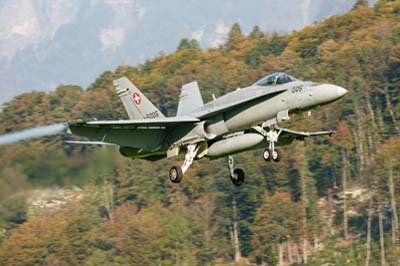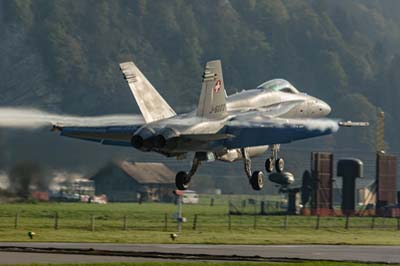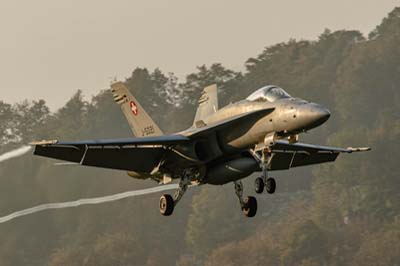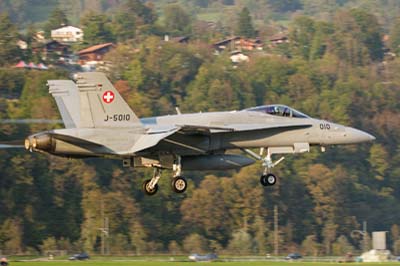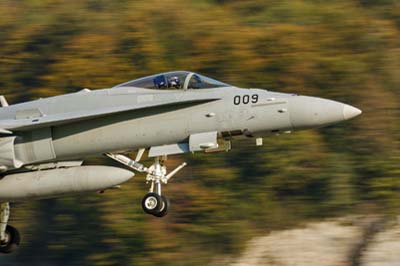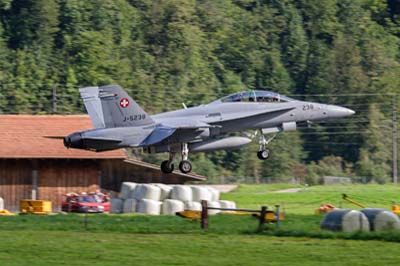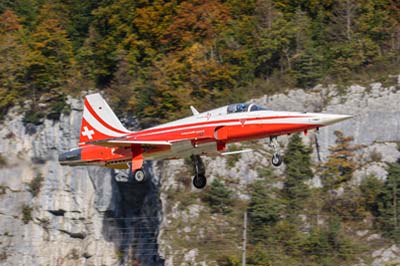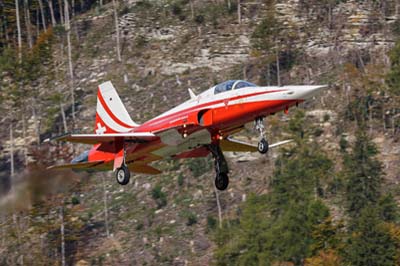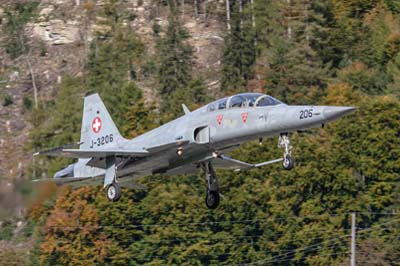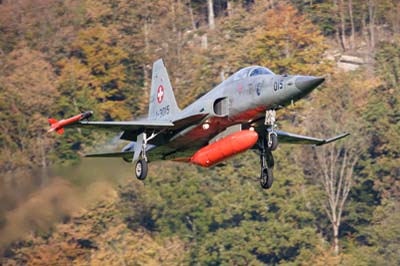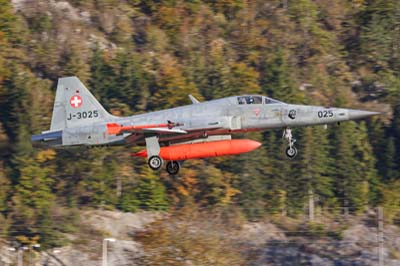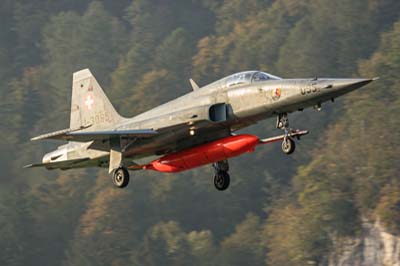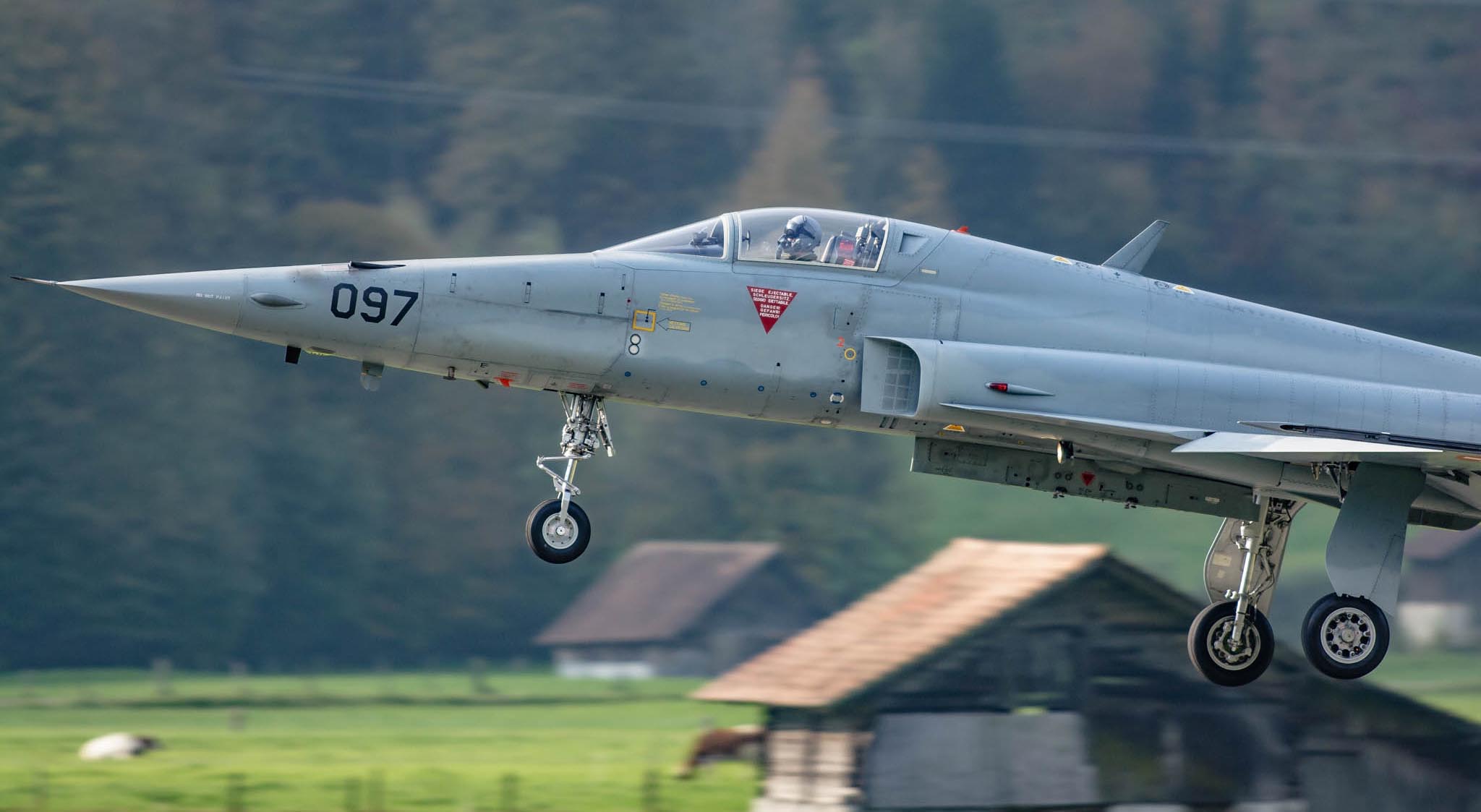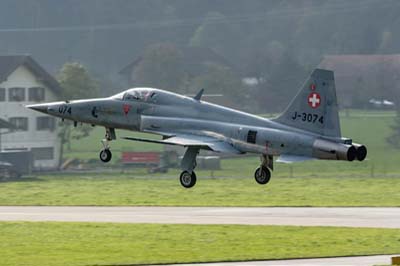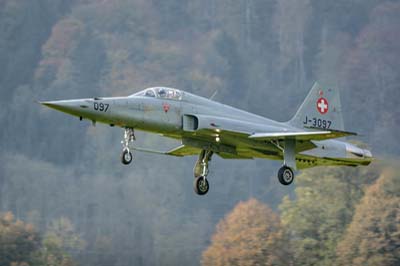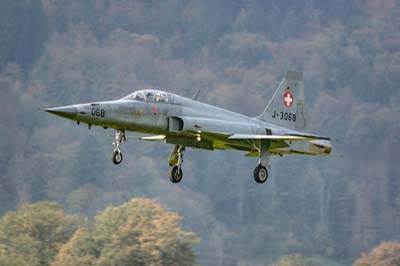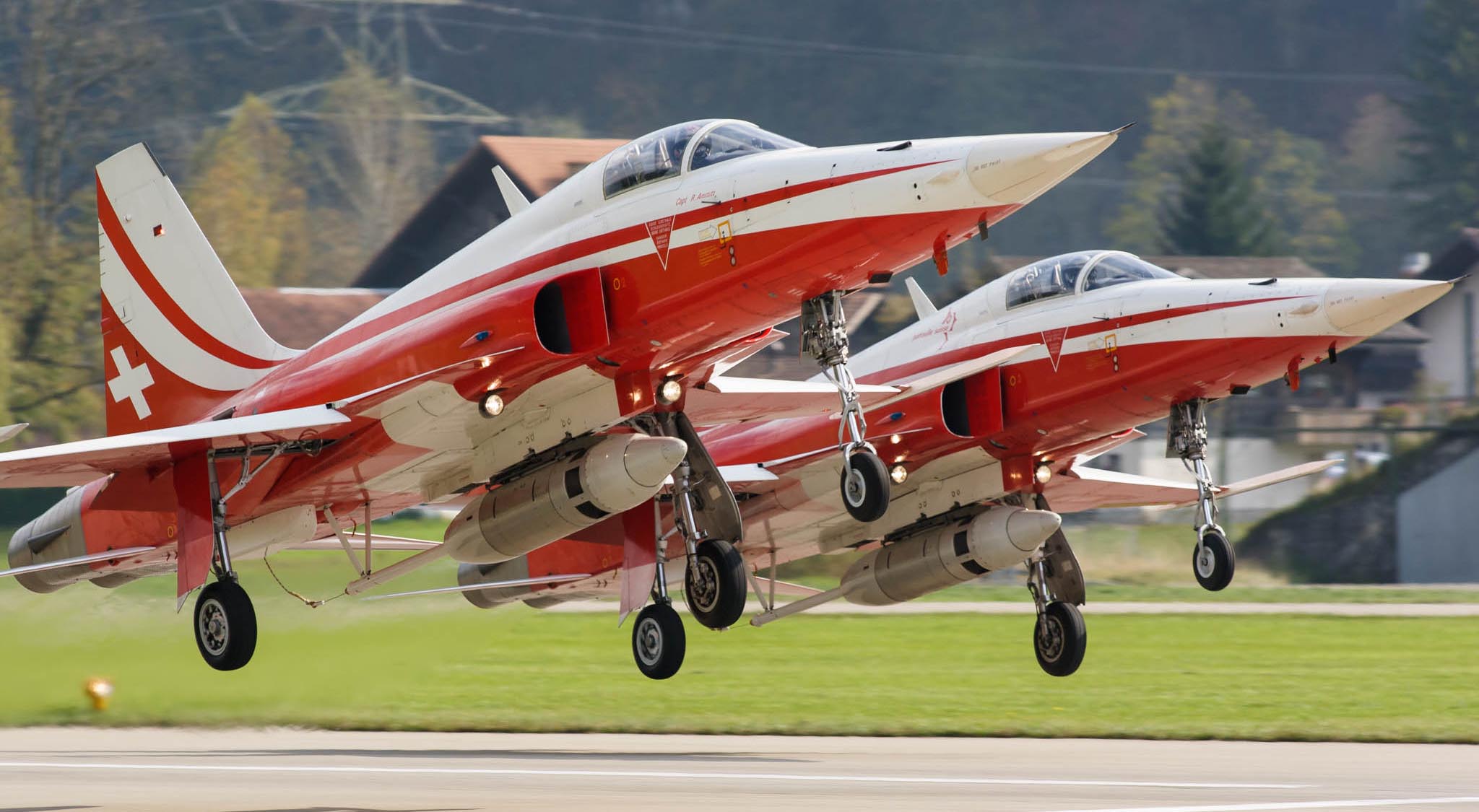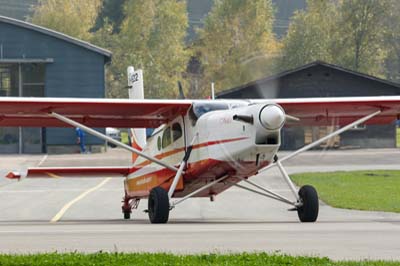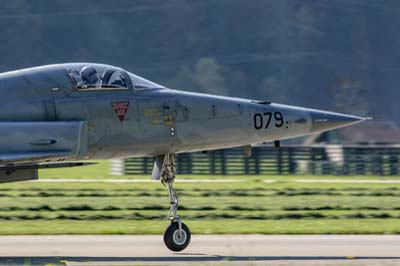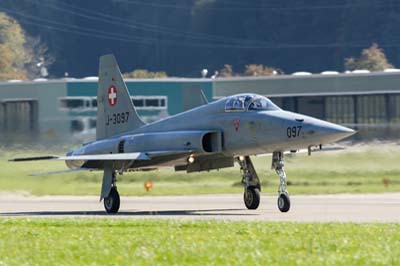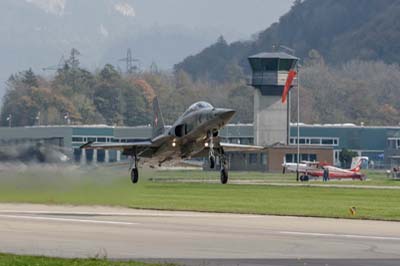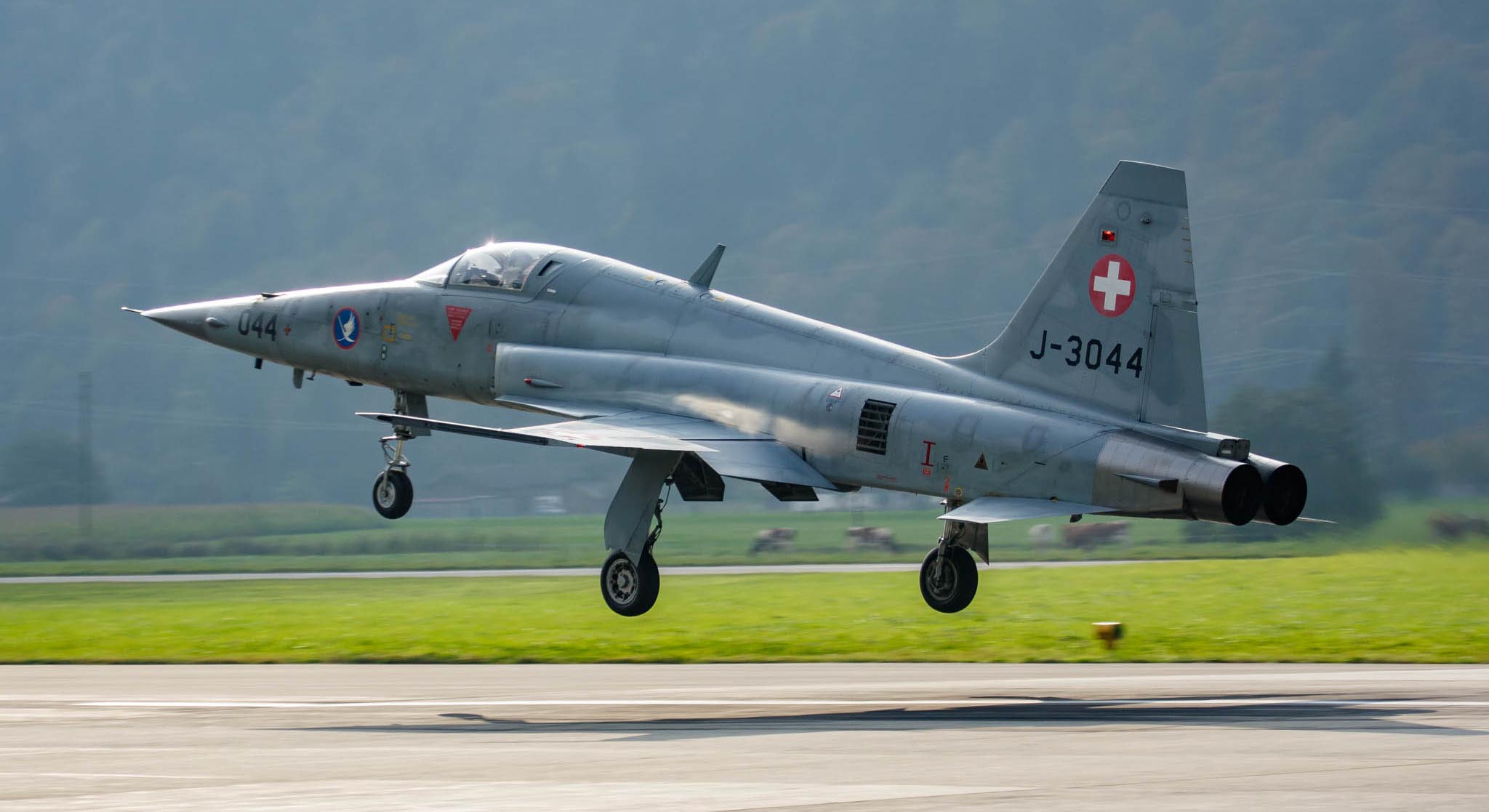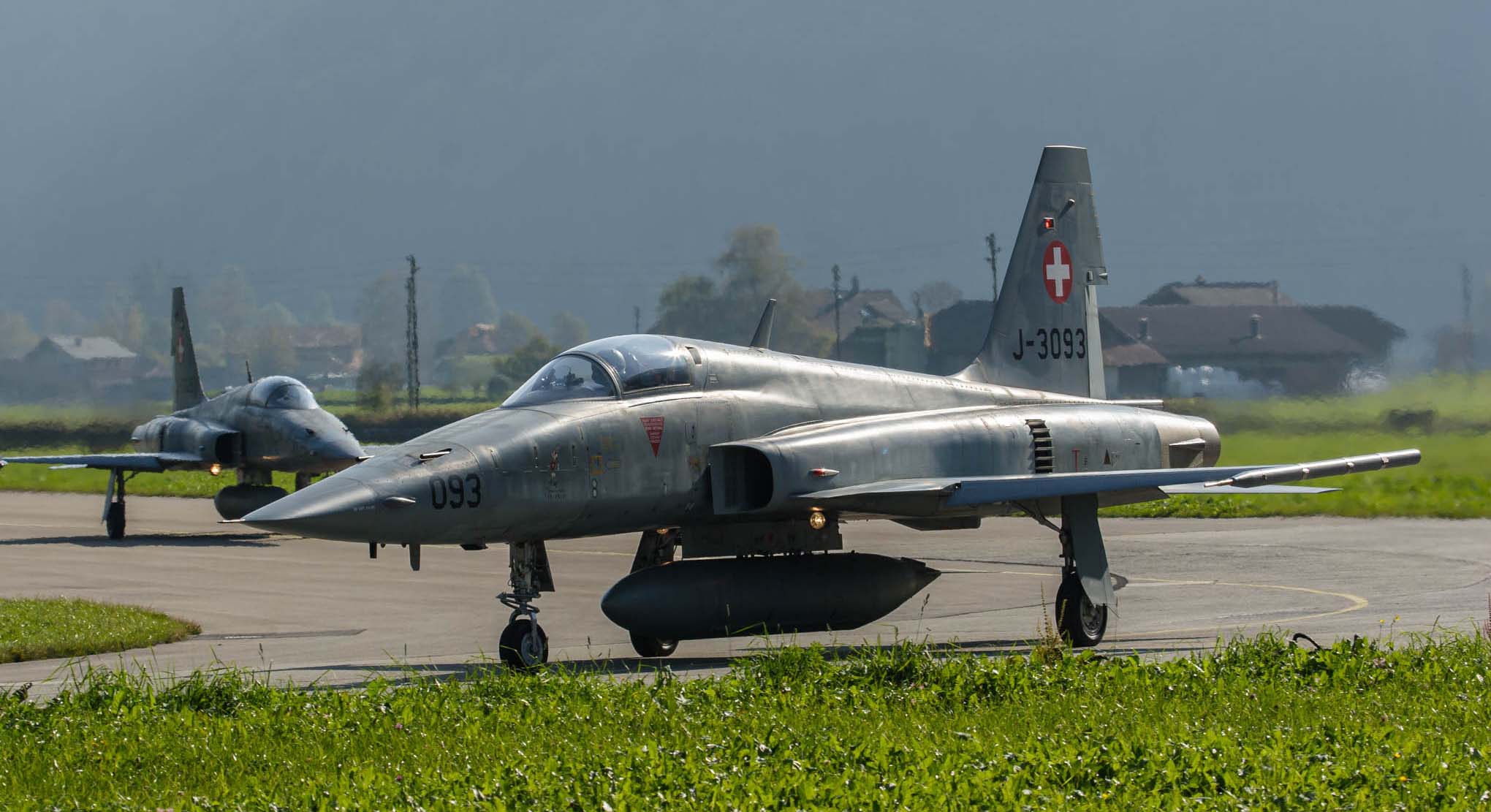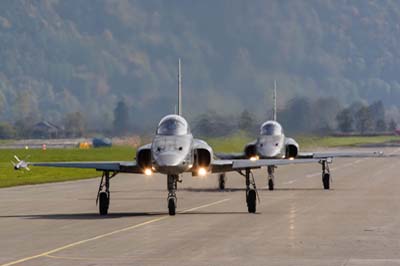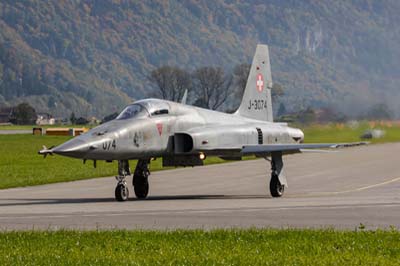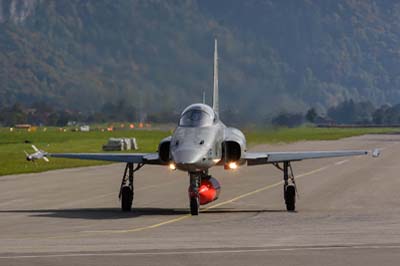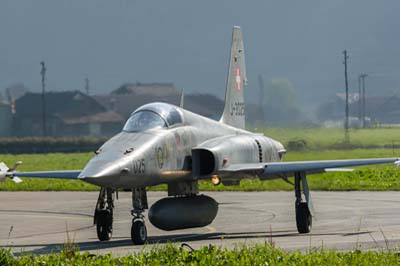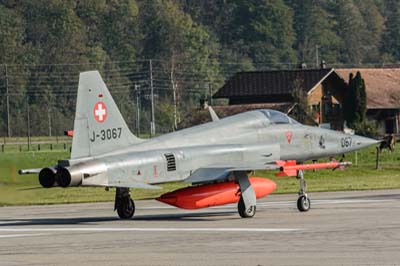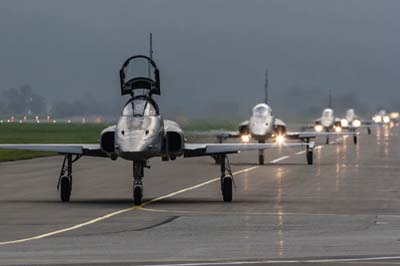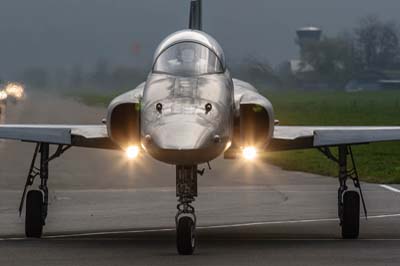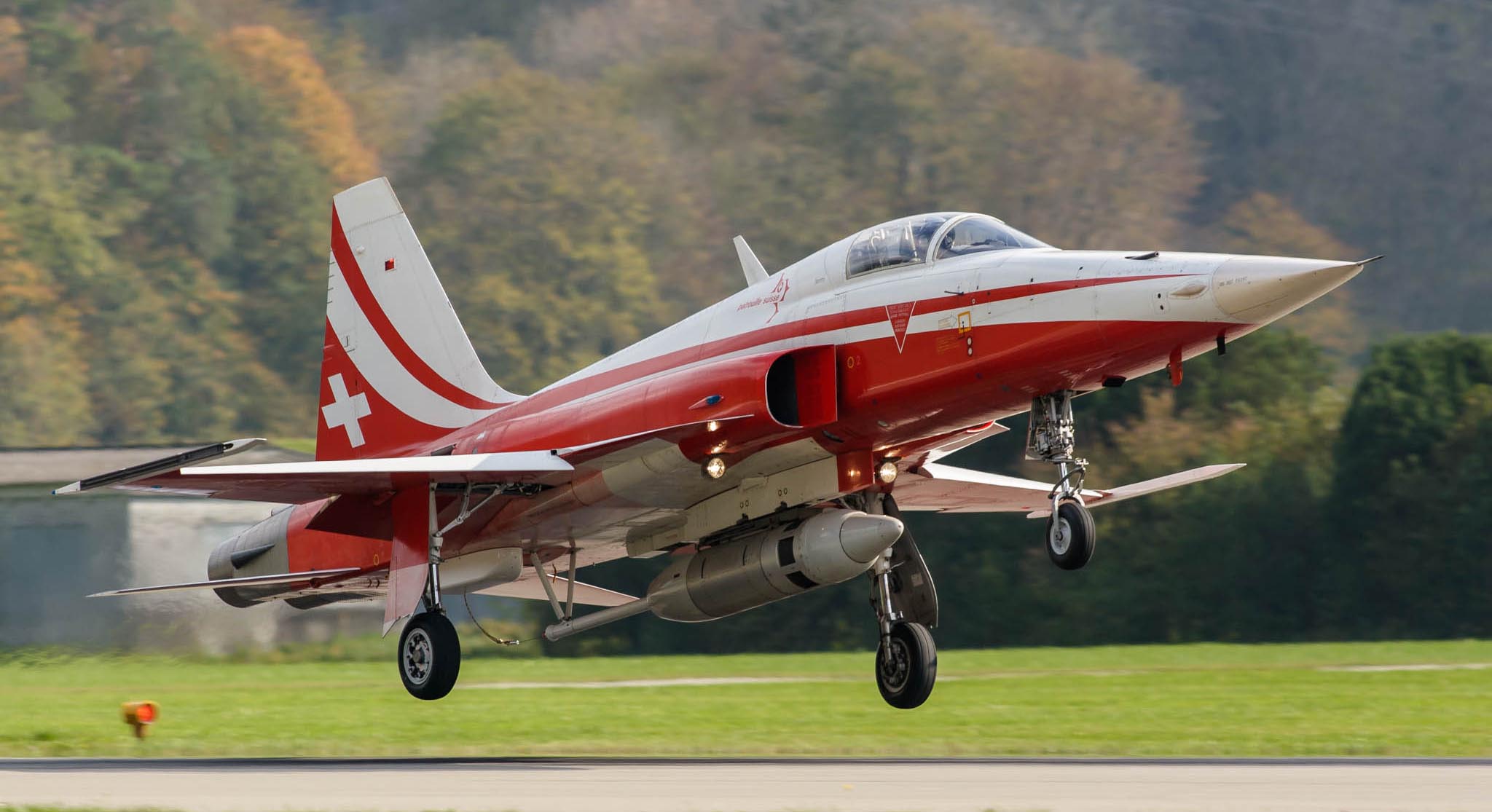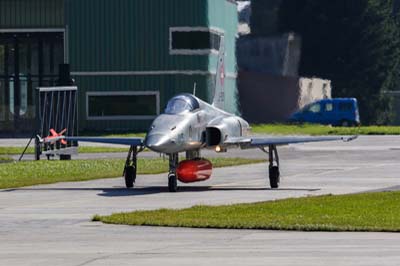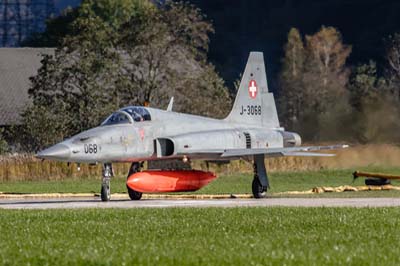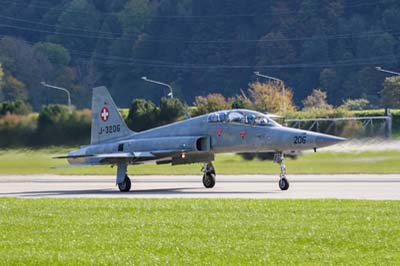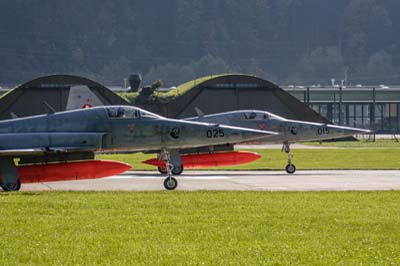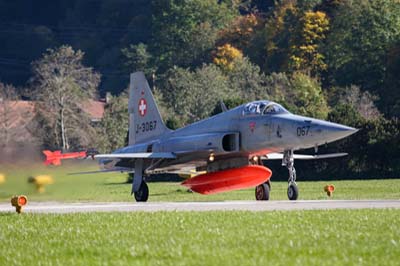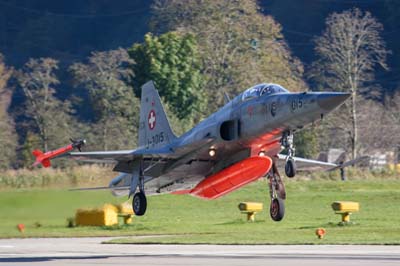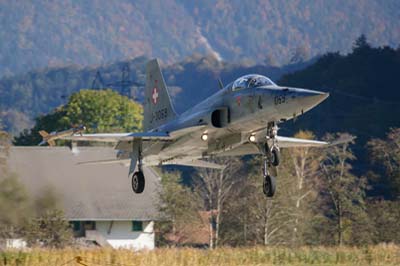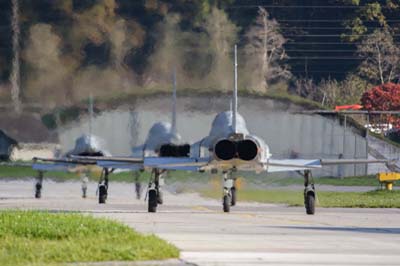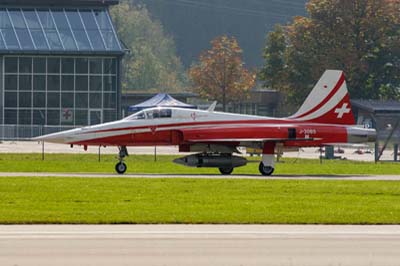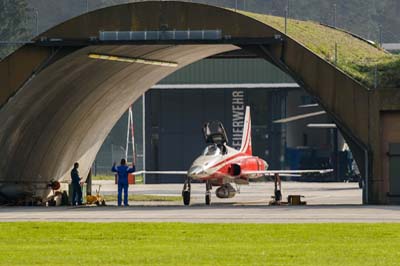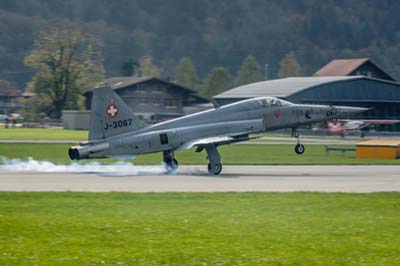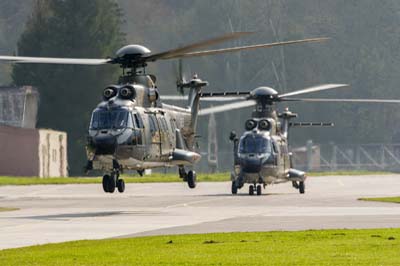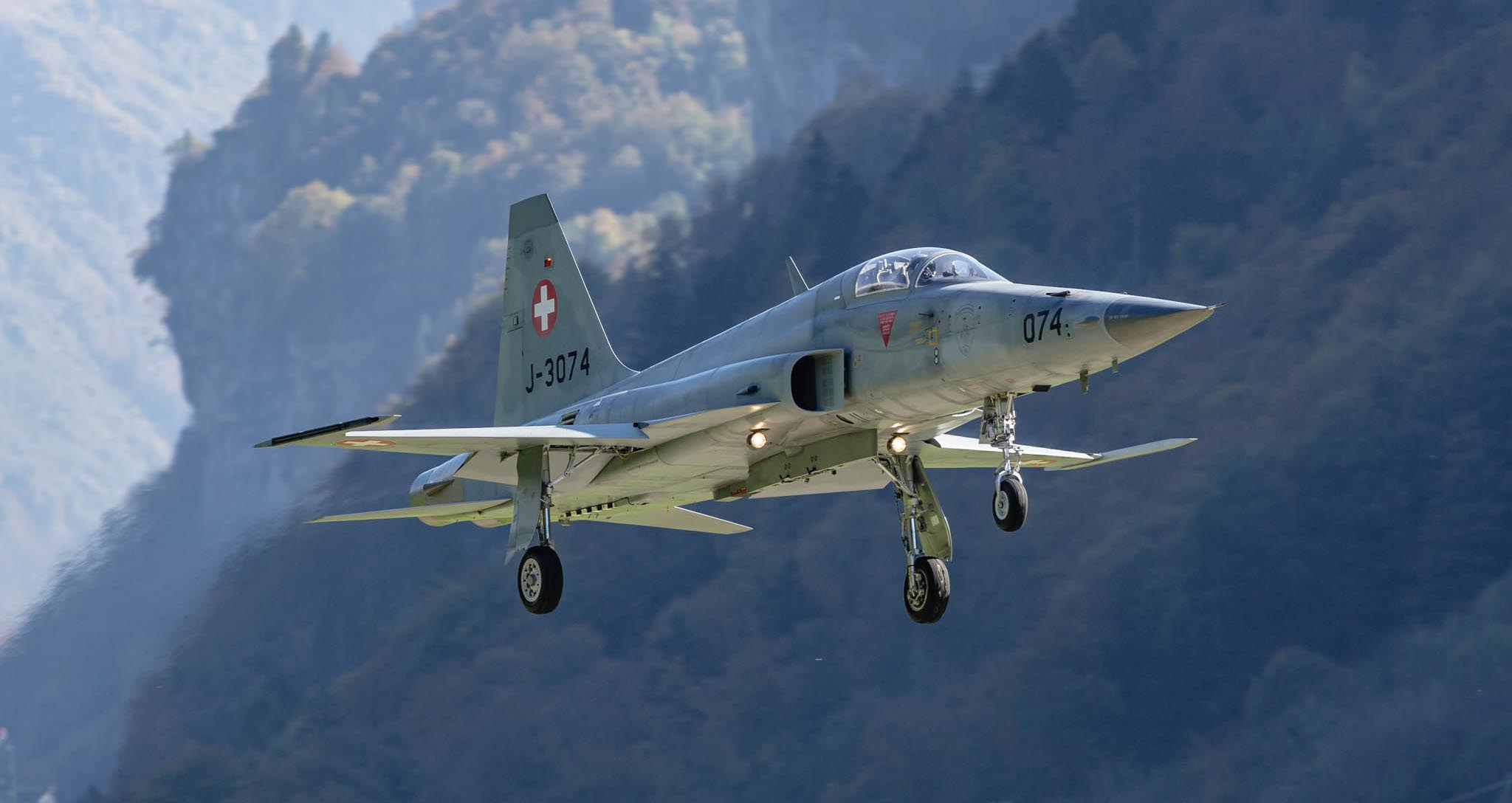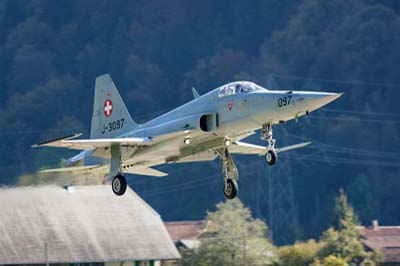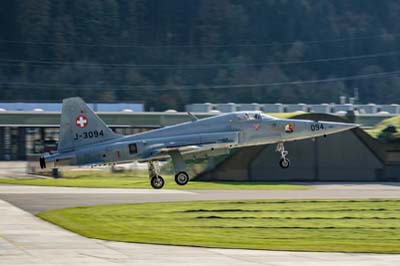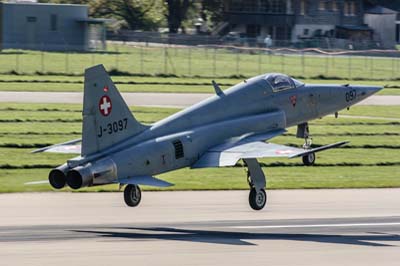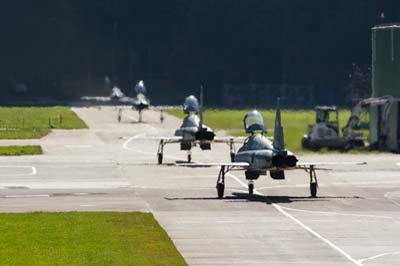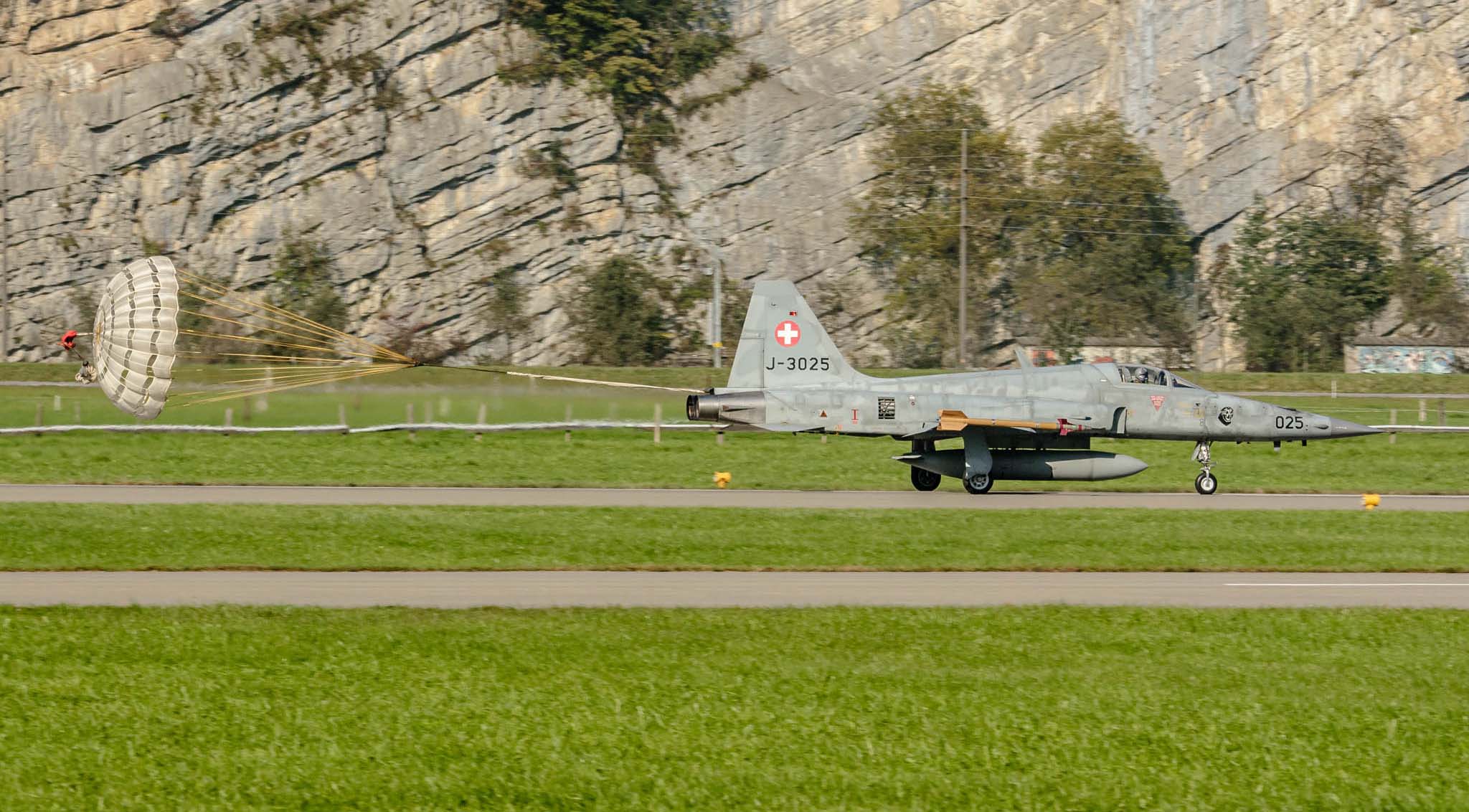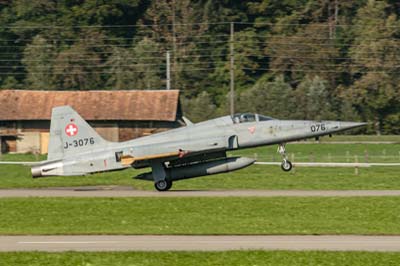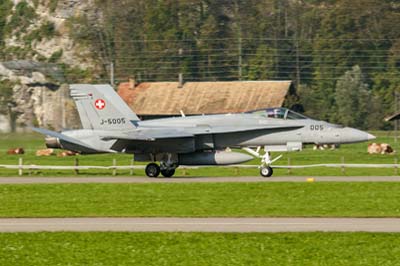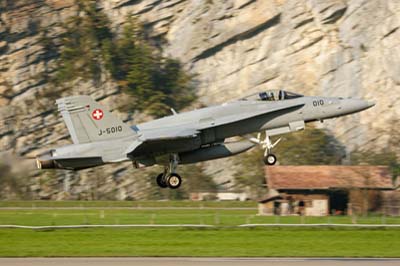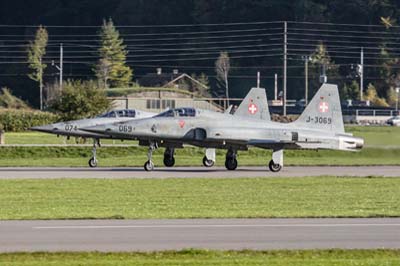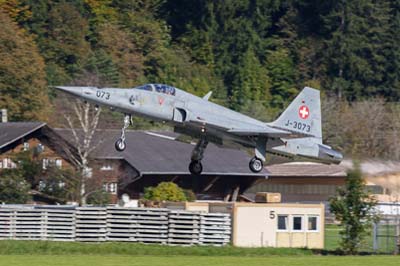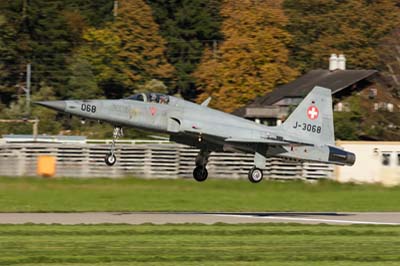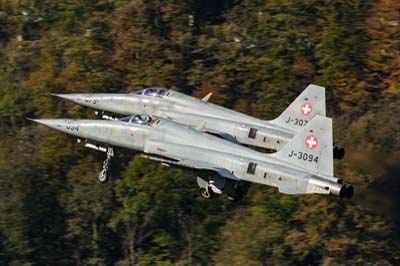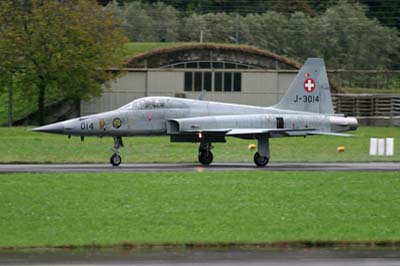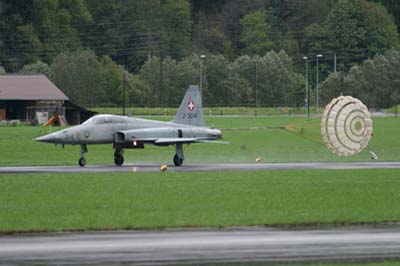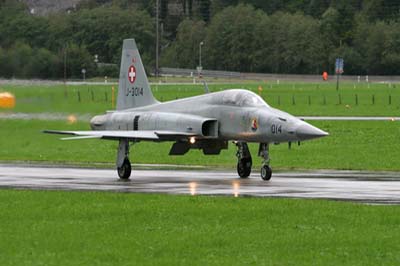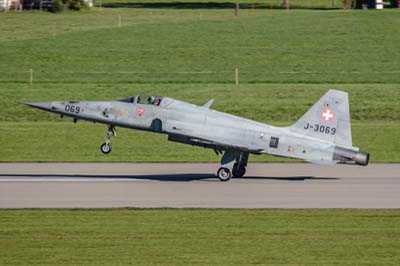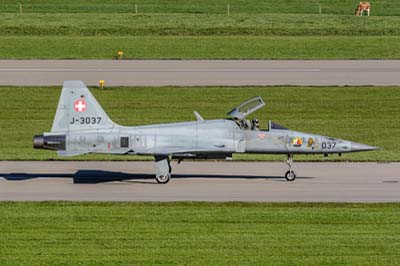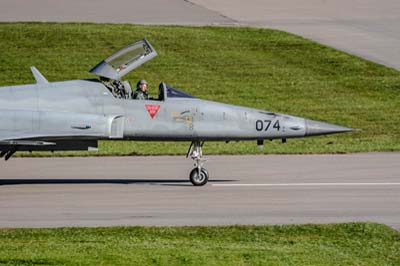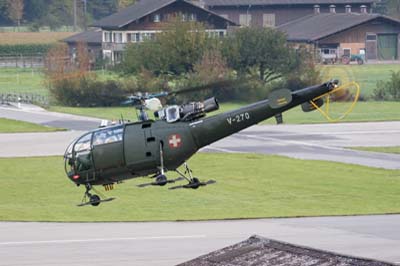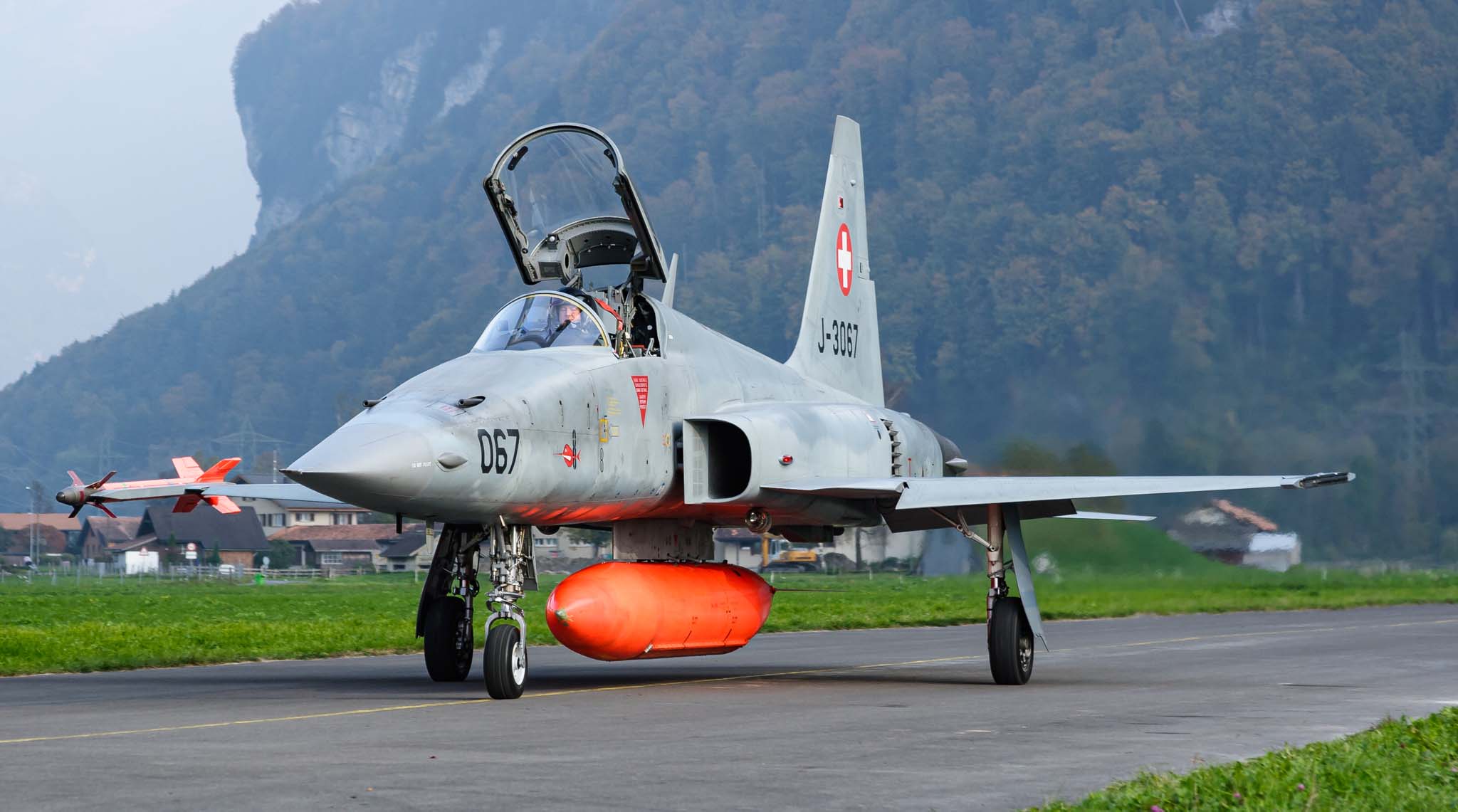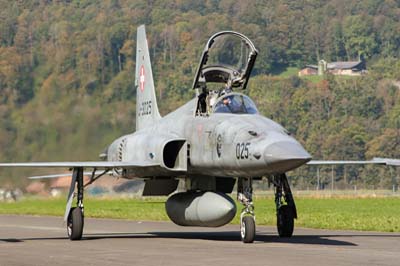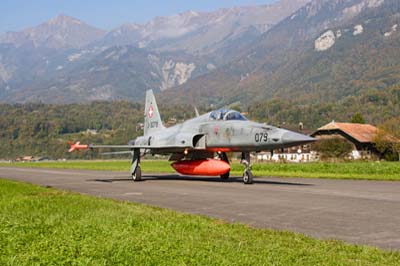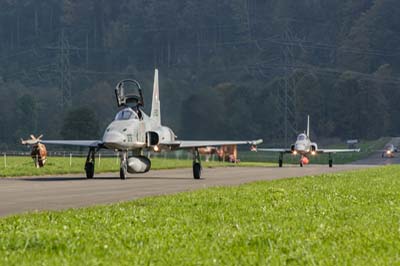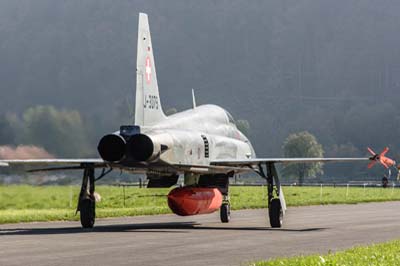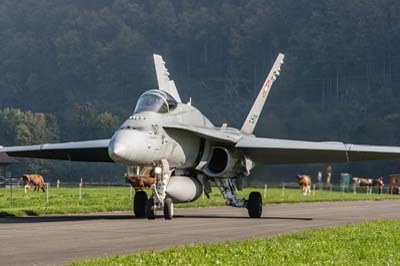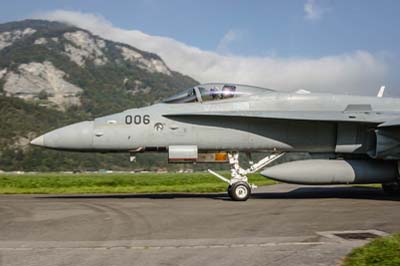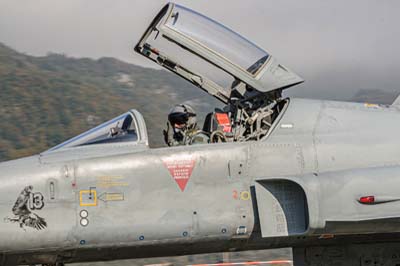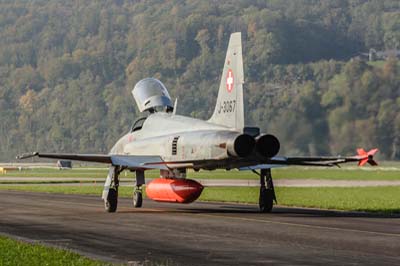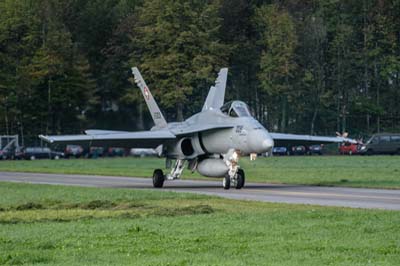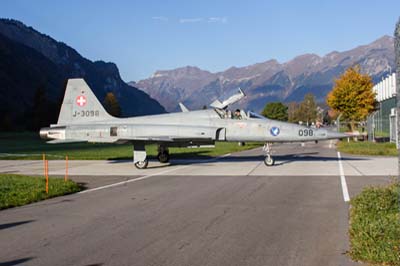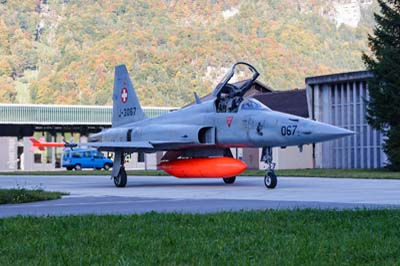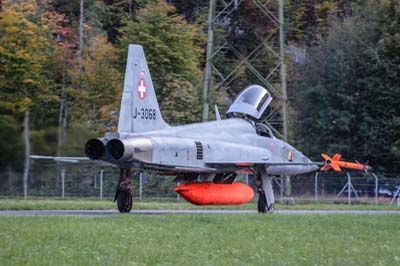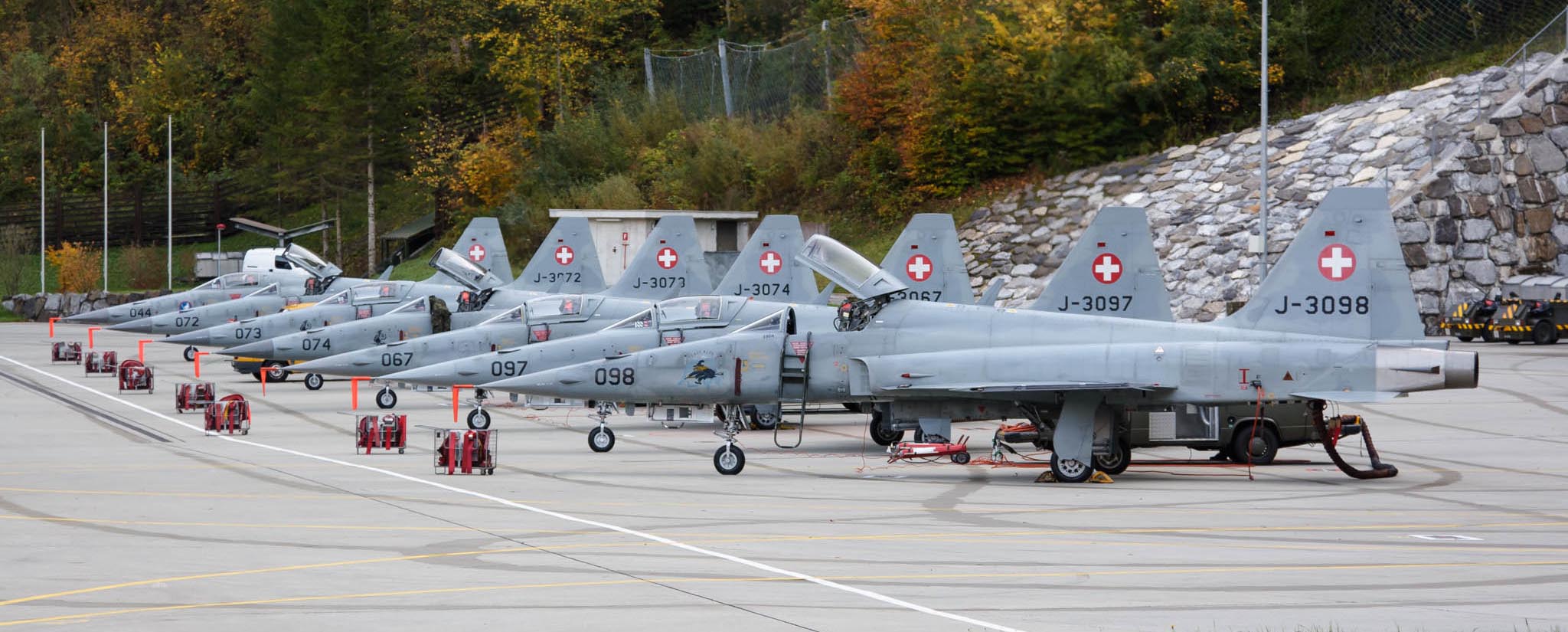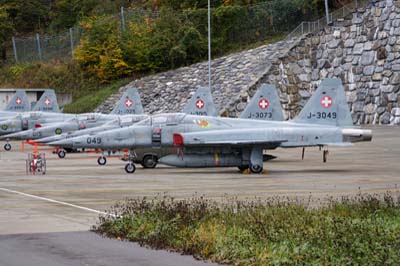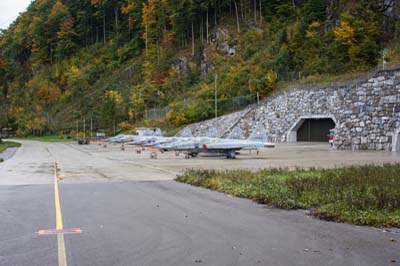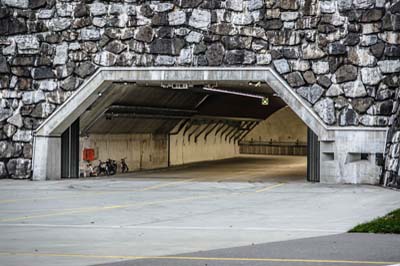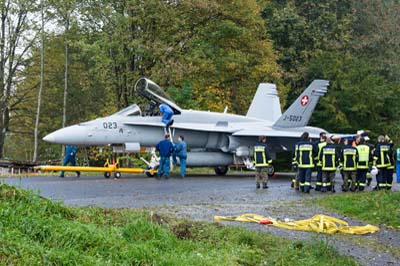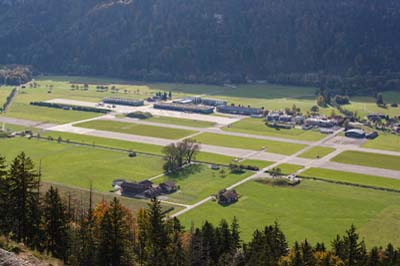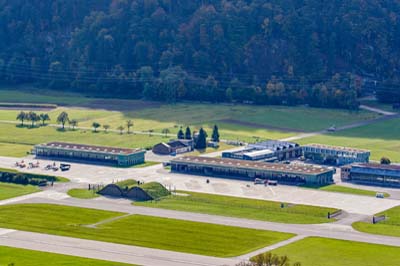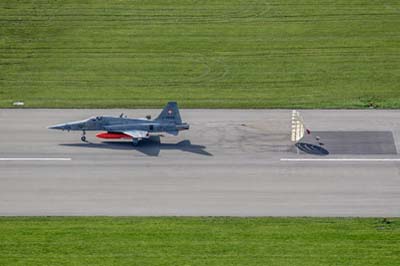Swiss Air Force Base, Meiringen - Unterbach
"One of the most photogenic airfields in Europe"
2003-2007
|
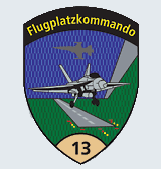 I have visited Meiringen-Unterbach on a number of occasions since 2003, each year trying to improve on what images I have and to find 'new' locations for some stunning images. The alpine backdrop, the close proximity of the aircraft from all around the base, surely make Meiringen 'One of the most
photogenic airfields in Europe'. Based here is Fliegergeschwader (FlGeschw) 13 who operate Fliegerstaffel (FlSt) 11 (F/A-18) and Fliegerstaffel 8 (F-5E).
I have visited Meiringen-Unterbach on a number of occasions since 2003, each year trying to improve on what images I have and to find 'new' locations for some stunning images. The alpine backdrop, the close proximity of the aircraft from all around the base, surely make Meiringen 'One of the most
photogenic airfields in Europe'. Based here is Fliegergeschwader (FlGeschw) 13 who operate Fliegerstaffel (FlSt) 11 (F/A-18) and Fliegerstaffel 8 (F-5E).
Meiringen-Unterbach air base
Meiringen did not become an official military air base until after World War Two. In the 1950s the Vampire operated from here following extensions to the runway and construction of the original cavern aircraft shelters. From 1958 until 1994 the Hunter operated from here for an amazing 35 years of continuous service.
In 1998 Meiringen started to be redeveloped with extensions to the famous underground hangars that are used to house its aircraft. The work was completed in 2003. The caverns needed to be adapted to house the new F/A-18s. The internal layout of the caverns remains highly classified. Further construction to its infrastructure started in 1999 under 'Project Luce' ('Light'). Following the closure of Dubendorf, Meiringen was selected for upgrading. The F/A-18s of FlSt 11 (Tiger Squadron) at Dubendorf were to be relocated, Meiringen was designated the wartime and training airfield and FlSt 11 moved here permanently in early 2006.
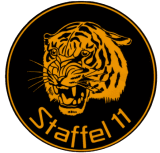 Meiringen is active for around 20 weeks in a year. The air base suffers from runway icing due to the narrow valley blocking the warming sun from the runway in the winter months. Fog and limited instrument-flying navigational aids add to the problems. Apart from Axalp week in October, the
Meiringen is active for around 20 weeks in a year. The air base suffers from runway icing due to the narrow valley blocking the warming sun from the runway in the winter months. Fog and limited instrument-flying navigational aids add to the problems. Apart from Axalp week in October, the
 air base is particularly busy in January during the World Economic Forum (WEF) when the F/A-18s are involved with Combat Air Patrol (CAP) duties. There are 100-200 sorties a week during this period. FlGeschw 13 also operates an intensive annual three-week wartime training course in March. A flying schedule is published
ahead of each year and shows for the active days flying times of Monday to Friday 08:00-12:00 and 13:30-17:00. F-5 sorties are often around 40 to 45 minutes in duration.
air base is particularly busy in January during the World Economic Forum (WEF) when the F/A-18s are involved with Combat Air Patrol (CAP) duties. There are 100-200 sorties a week during this period. FlGeschw 13 also operates an intensive annual three-week wartime training course in March. A flying schedule is published
ahead of each year and shows for the active days flying times of Monday to Friday 08:00-12:00 and 13:30-17:00. F-5 sorties are often around 40 to 45 minutes in duration.
The airfield is situated in a very narrow valley, with high and shear rock faces each side and is surrounded by snow covered peaks. The single runway and parallel taxiway runs roughly from east to west. A dozen or so grass covered shelters lay back from the runway on each side. Curiously a farming community is integrated within the airfield itself. Livestock graze around the hangers and surrounding taxiways. At weekends the whole airfield appears to be at their disposal. Taxiways, littered with farm machinery, go towards the rock cliffs (you are able drive up these when not in use) and on to underground hangars or caverns. The cavern area off limits of course. A public road goes straight across the middle of the airfield, barriers similar to a railway crossing come down minutes before incoming or out going aircraft. If that is not enough to alert you to take up position with your camera, then a large light at the top of the air traffic control tower starts flashing. Another public road with similar electronically operated barriers crosses the runway at the western end of the airfield.
The Northrop F-5E/F Tiger II with the Swiss Air Force
Under the Foreign Military Sales (FMS) program 'Peace Alps' 66 F-5E were supplied, 53 of which were assembled by FFA with 6 F-5F to the Swiss Air Force. Under 'Peace Alps (?)' a further 32 F-5E and 6 F-5F were supplied. Deliveries of the F-5E/F Tiger II commenced in October 1978. The 98 F-5Es given serials J-3001 to J-3098) and the twelve two-seat F-5Fs J-3201-J-3212. By 1985 the Swiss Air Force was looking to replace some of its F-5Es and Mirage IIIS to improve its air defence capability. The F/A-18 was eventually selected. The first two were US built and delivered in 1996. The rest of the 26 Cs and eight two-seat D variants were assembled at Emmen between 1997 and 1999. In 1998 FlSt 18 at Payerne converted to the F/A-18 from the F-5E, FlSt 11 at Dubendorf followed in 1999. As a result of the Arméé XXI structure to produce a leaner military that commenced on January 1, 2004, operational F-5E numbers were reduced. 32 were sold to the US Navy and 12 were leased to the Austrian Air Force. FlGeschw 3/FlSt 1 at Turtmann, FlSt 13 at Payerne and FlGeschw 10 at Buochs were all disbanded in December 2003.
Currently FlSt 19 is at Sion, FlSt 8 at Meiringen and EscAv 6 at Payerne, Ausbildungsstaffel 16 (Training Squadron 16) with its two-seat F-5Fs is responsible for primary jet training, target-towing and Electronic warfare is also at Payerne. The F-5F is also used for Dissimilar Air combat training (DACT) with the F/A-18s. ECM training is also carried out using Ericsson Erijammer A-100 'Vista 5' electronic jamming system. The Patrouille Suisse display team operate from Emmen. |
F-5 Squadron badges past and present.
Photography at Meiringen
Many of the locals and especially during Axalp week and a number of aviation photographers from across Europe, assemble around the road barriers on each side of the airfield. There is usually a relaxed attitude by the Swiss Air Force so that photographers can enjoy the action at close proximity. However I have seen people go down farm tracks to climb on shelters that on actually on the airfield. Airfield security on those occasions are swift to react and escort the offenders away from the airfield. In 2007 perhaps as a reaction to airfield incursions 'No Pedestriains' signs have been put on on most of the farm tracks which lead towards the taxiways and runway. Security appears to be relaxed about people walking down most of these tracks during Axalp week, however the track at the western end is monitored and roped off at this time, so please when indicated do not pass into any forbidden areas. The main ramp is protected by a high fence and is constantly patrolled by guards and their excited dogs. Never-the-less a ramp shots can be taken through the fence.
The annual Air Power Demonstration at the Ebenfluh Firing Range at Axalp every October is a must for all aviation photographers. However Meiringen situated just below the range should not be over-looked. The F-5E Tiger IIs are especially active during Axalp week. Each day of the demonstration 300+ VIP's are ferried up to the range by Super Puma or Cougar from here. Numerous flights of Alouette IIIs perform liaison duties as well as shown below, carry portable toilets and other equipment and supplies.
Every year in the previous five I have visited Meiringen looking for more photographic locations around this stunning air base. The wind direction which dictates the landing and taking off direction, the weather and the time of day all greatly influence the location to go to and the nature of the images you take.
The report that follows has been produced to
emphasise the numerous photographic opportunities that can be had at one of the most
attractive air bases in Europe. Many of the photographs included have been chosen
because of the setting rather than for the subject, so please look further than the aircraft
depicted.
The following images were taken at the many distinct locations indicated, they are all accessible to the public.....
Don't forget that the sun does not shine onto the airfield during January! |
At the south side barrier of the road that crosses the centre of the airfield. See 'M21' on Meiringen Map
You can park your car in the museum (which houses an F-5E and Alouette III) car park. This is the best place for lifting off shots of aircraft taking off to the east only (see M14 for east to west take-offs), using a 300mm telephoto lens. Visiting light aircraft will park on the ramp in front of the museum hangar and are easily photographed with a wide-angle lens. Remember F/A-18s need less runway and are well into the air from here. |
A pair of Northrop F-5E Tiger IIs (J-3049 with J-3073) depart to the west.
J-3049 still retains the 'Goodbye Turtmann 2003' artwork on the fuselage, from when Turtmann air base was closed two years earlier. |
Left to right: F-5E (J-3092) cross-over it has a Fliegerstaffel 11 badge on both sides nose. Fliegerstaffel 11 converted in 1999 to the F/A-18 at Dubendorf the photograph was taken four years later. F-5Es have carried a variety of squadron badges over the years, they are often still carried long after the aircraft has been transferred to another squadron or the squadron has been disbanded. They are sometimes different on each side and so they are not a reliable indication as to which squadron the aircraft is currently operating.
F-5E (J-3060) the pilot is giving a friendly wave.
A pair of F-5E Tiger IIs (J-3008 with Fliegerstaffel 19 badge on nose with J-3060) depart, the narrow steep sided valley is a great back drop.
F-5E (J-3014) just about to touchdown following its approach from the east. A 300mm lens is ideal from here. |
Meiringen will get the occasional visitor and there is not better place than the road barrier at the centre of the airfield.
Left to right: Pilatus PC-6 Turbo Porter's (V-622 and V-633). In October 2007 it was the first time the new Patrouille Suisse painted PC-6 had been seen. It is used as there communications aircraft, on this visit it brought in the Patrouille Suisse commentator for the Axalp Air Power Demonstration. He was later ferried up to the firing range by Alouette III. Pilatus PC-7 Turbo Trainer (A-940) departs just 15 minutes after its early morning arrival. |
There is also plenty of helicopter activity at Meiringen. Various images of Alouette IIIs from three different locations.
Left to right: Alouette III V-250 arrives; V-255 returns with a portable toilet; V-261 up real close and V-254 about to land (note: shutter speed of 1/100 to give a full 360 degree blur to tail rotor). |
Super Pumas and Cougars were used to transport 300+ VIP's up to Ebenfluh Firing Range each day.
Left to right: Aérospatiale AS.332M-1 Super Puma TH-89 (T-312) and Eurocopter AS.532UL Cougar TH-98 (T-332) with 'ISSYS' self protection system fitted just to left of serial.
AS.332M-1 Super Puma (T-325) lens used 24-105mm at 92mm 1/80th. |
|
Left to right: The more powerful F/A-18 Hornet (F/A-18D J-5238 and F/A-18C J-5017) needs less runway and has a steeper and more impressive climb out than the F-5, so positioning for photography must take this into account. The final shot is of a F/A-18C (J-5010) rolling out after landing, it is crossing the public road which runs through the middle of the airfield. |
At the road barrier at the western end. See 'J1' on Meiringen Map
This is one of the best places for aircraft landing from the west. You have the sun behind you and a great backdrop, especially in the evening sun. |
| F/A-18C Hornet (J-5021) landing in the evening sun. |
| Left to right: F/A-18Cs (J-5014 and J-5023) return at 9:30 after their first sortie. F/A-18Cs (J-5021 and J-5010) close the flying for the day at 17:30. |
Left to right: F/A-18C (J-5009) taken with a shutter speed of 1/160th to blur the background, two-seat F/A-18D (J-5238) looks like it is landing in a farm yard, such is
the close proximity of the farming community.
Two Patrouille Suisse F-5Es (J-3086 and J-3091) add some colour to the already photogenic backdrop. |
Left to right: This two-seat Northrop F-5F Tiger II (J-3206) is based at Payerne with the Jet-Pilotenschule II.
F-5Es (J-3015, J-3025 and J-3095) with central orange drop tanks and dummy AIM-9P Sidewinder training rounds. These aircraft are used as 'aggressors' when engaged in Air Combat Manoeuvring (ACM) dog fighting.
The first three images were taken mid-morning while the fourth image was taken at the end of the day in evening light. |
From the slip road pavement at the north western end. See 'F2' on Meiringen Map
This is an excellent elevated position close to the airfield threshold, a 300mm lens is ideal for the approaching shots. As you are looking directly towards the setting sun, this location is best in the early morning for landings from the west or on overcast days. |
| Left to right: F-5Es (J-3074, J-3097 and J-3068) return in the early morning at the western end. J-3068 carries the Flugplatz Kommando 13 (air base Command 13) badge in low-vis on the nose. |
From the northern side of the runway. See 'J17 to 'J19'' on Meiringen Map
This is the rotation point for take-off's to the west, it appears you can walk into a grass field from a small car park by the northern central road barrier. This may not be a public area so be careful not to upset any farmers. |
F-5Es (J-3080 and J-3089) lift off with air to air target banner equipment,
J-3080 has had the Patrouille Swiss titles removed. |
Left to right: Patrouille Suisse's Pilatus PC-6 (V-622) named 'Felix' taxiing from the visitor ramp to the runway.
F-5E (J-3079), it has just started to rotate on take-off. The nose gear has been extended lifting the nose by 3 degrees for the take-off decreasing the rotation point by 50%.
F-5E (J-3072) departs to the west in October 2007. The new squadron and command buildings constructed under 'Project Luce' can be seen behind the control tower. |
From the farm track north western end . See 'H6' on Meiringen Map
This track runs parallel and very close to the runway. It was marked in 2007 as a 'No Pedestrian' way, so make sure that you don't upset farmers and airfield security alike. During Axalp week everyone seemed very relaxed with the presence of quite a few photographers and local on-lookers. |
F-5E Tiger II (J-3044) touching down from the west in the early morning
(100-400mm lens at 115mm) |
The farm track south side at the western end. See 'J3' on Meiringen Map
These shots were taken from the end of a farm track at the western end at the turning point of the parallel taxiway. In 2007 this was one of the tracks with a new 'No Pedestrians' sign. Also a rope was put across the track and frequent visits by airfield security were on hand to enforce the exclusion. This location produces some stunning back-lit shots of nose-on taxiing aircraft in the early morning light. |
| F-5E Tiger II (J-3093) back-lit in the mid-morning light. |
From a farm track at the western end the aircraft taxi towards you down the long parallel taxiway.
See early morning shots
Left to right: F-5Es J-3069, J-3074 and J-3025 x2). |
Left to right: F-5Es (J-3067). Many of the sorties appeared to be for 1v1 or 2v2 Air Combat Manoeuvring (ACM). The central orange drop tanks and dummy AIM-9P Sidewinder training rounds are carried to distinguish the 'aggressors' when engaged in dog fighting.
Ten F-5Es (J-3079 and J-3068) taxi down the parallel taxiway for the first launch of the day at 8:30. |
A farm track which runs to the north eastern end of runway. See 'K23 to K25' on Meiringen Map
This farm track runs from the northern side central road barrier beside a fast flowing stream which acts as the airfield boundary, there is no fence. You can stand anywhere along this track for some excellent landing shots from the east. You are looking into the sun, but that just provides some interesting back-lit shots. The runway is very close here, full-frame side on shots only need a 135mm lens. |
Down at the eastern end, north side for the departing aircraft. You will be looking in to the sun, but hey it does offer some interesting light and angles. The parallel farm track is just 60 yards away across a drainage ditch to the touchdown point.
Left to right: F-5E (J-3015) taxis out to the runway from the cavern area; F-5E (J-3068) turns on to the runway; two-seat F-5F (J-3206) roars down the runway; F-5E aggressors (J-3025 with J-3015) approach the mid-point of the runway on the take-off run. |
| Left to right: F-5Es J-3067 awaiting clearance for take-off at the eastern end, J-3015 and J-3069 are about to touch down. A line of F-5Es return to the cavern area. |
Left to right: After returning from the afternoon sortie, the two air to air target towing equipped F-5Es taxied into the Quick Reaction Alert (QRA) Hardened Aircraft Shelters (HAS) just off the main ramp (300mm lens).
F-5E (J-3067) tyre smoke on touchdown adds to the action (100-400mm lens at 115mm).
Two AS.332M-1 Super Puma's (T-325 and T-312) set off for Axalp to collect the VIP's at then end of the show. |
From on top of an old grass covered shelter down the farm track which runs to the north eastern end of runway. See 'K26' on Meiringen Map
This farm track runs from the northern side central road barrier beside a fast flowing stream, it leads to a grass covered hardened shelter just to the left of the track. |
| F-5E Tiger II (J-3074) moments before touch down. |
| Left to right: F-5Es (J-3094 and J-3097 x2) the extra height enables you to look down onto the runway. Four F-5Es taxi back to the cavern area. |
From the roadside on southern side, midway along runway. See 'M13' on Meiringen Map
From this point you are closest to the runway. It is ideal for lifting off shots using a 300mm and is also good for taxiing shots using shorter lenses. |
| F-5E (J-3025) deploys it's parachute rolling out on landing. |
| Left to right: F-5E (J-3076) and F/A-18C (J-5010). |
Departing to the west in pairs or as singletons.
Left to right: (J-3069 with J-3074, J-3073, J3068 and (J-3094 with J-3079) |
| Left to right: After touching down from the east F-5Es (J-3014) deploys chute before taxiing back to the main ramp area. |
| Looking down from an elevated position as the F-5s return down the main parallel taxiway towards the main ramp. |
Left to right: F-5Es (J-3069, J-3037 and J-3074) arrive in the early morning sun after their first sortie of the day. Early morning departure Alouette III (V-270).
J-3069 has a black Fliegerstaffel 13 Squadron badge on the nose.
J-3037 has a yellow/red/blue badge inscribed 'Flugplatz Abteilung 3 and Fliegerkompagnie 8' (Air Base Section 3 and Aviation Company 8) on the nose with also 'Tiger + 20' nose art. |
The taxiway between caverns and western end of runway. See 'Q16' on Meiringen Map
This taxiway is not always in use, it is often cluttered with farm machinery with a bus stop in use halfway down and crossing the taxiway. |
| F-5E Tiger II (J-3067) leaving the cavern area for the final sortie of the day. |
F-5Es returning to the cavern area for lunch, some were using the eastern taxiway, these F-5s were using the western route. This is a good place to try and get shots with cows in the background, demonstrating the rural nature of the airfield and how at ease the livestock are with the jets.
In October aircraft come from the shadows into the evening sun. By 16:30 the shadow will have moved halfway down the taxiway towards the runway. An hour later the whole airfield is in shadow. |
Left to right: F/A-18Cs and F-5Es make their way to the runway along the western taxiway from the cavern area for the first afternoon sortie.
The third image of F-5E has a Fliegerstaffel 13 badge from before they disbanded in December 2003. |
The crossing of the eastern taxiway and the public road to Meringen town . See 'Q25' on Meiringen Map
The public road past the main entrance of the air base from Unterbach to Meiringen is crossed by the eastern taxiway which is used by aircraft moving from and to from the cavern area. |
Left to right: F/A-18C (J-5009) emerges from the cavern area to taxi out down the usual eastern taxiway at 08:15 as part of the days first four ship.
F-5Es (J-3098) taxis from the caverns and across the public road, it has a Fliegerstaffel 19 squadron badge on the nose. This wide-angle lens shot shows how close you can stand, I am at the road barrier.
F-5Es (J-3067 and J-3068) returning to the caverns at the end of the day. The shadow from the mountain side is now covering nearly half the southern side of the airfield. |
The end of the western taxiway by the caverns. See 'V20' on Meiringen Map
At the end of this taxiway the cavern area can be seen from a secure gate. Public footpaths run from this area in a number of directions. |
| F-5E Tiger II (J-3098) with 'Peace Alps II' nose art, in lineup out side the new cavern entrance. |
To the south of Meiringen air base are the underground caverns which are used to house the deployed or based aircraft. Outside the cavern entrances there is a ramp area where the groundcrew prepare the aircraft between sorties. Once the protecting barriers have been opened and the road barriers dropped, the aircraft will taxi out of the cavern area. From the eastern taxiway they cross over a public road before passing between airfield buildings and on to the runway.
Left to right: Three views of the cavern entrance and ramp area to the south of the base. (J-3049 with the 'Goodbye Turtmann 2003' artwork).
An incident in 2006 with an F/A-18C just outside the cavern area on the western taxiway. |
The north side mountain pass road over. See 'A16' on Meiringen Map
These panoramic shots were taken from the main road to Brunigpass which goes up along the northern mountain side from the north western end of Meiringen air base. |
Left to right: General views of Meiringen-Unterbach from the North side. Both images show the main air base buildings and the main taxiway off base to the caverns.
The F-5E with shut deployed image was taken with a 300mm lens and has been cropped for affect. |
Tourist Office Information:
Reading through some local Tourist Office information I discovered that there are regular guided tours of Meiringen Air Base. In 2005 they were on June 9, August 25 and October 27 and ran from 14:00 to 16:30. For further information and booking of tours you must telephone the local Tourist Office only, on 033 972 6464. |
 I have visited Meiringen-Unterbach on a number of occasions since 2003, each year trying to improve on what images I have and to find 'new' locations for some stunning images. The alpine backdrop, the close proximity of the aircraft from all around the base, surely make Meiringen 'One of the most
photogenic airfields in Europe'. Based here is Fliegergeschwader (FlGeschw) 13 who operate Fliegerstaffel (FlSt) 11 (F/A-18) and Fliegerstaffel 8 (F-5E).
I have visited Meiringen-Unterbach on a number of occasions since 2003, each year trying to improve on what images I have and to find 'new' locations for some stunning images. The alpine backdrop, the close proximity of the aircraft from all around the base, surely make Meiringen 'One of the most
photogenic airfields in Europe'. Based here is Fliegergeschwader (FlGeschw) 13 who operate Fliegerstaffel (FlSt) 11 (F/A-18) and Fliegerstaffel 8 (F-5E). Meiringen is active for around 20 weeks in a year. The air base suffers from runway icing due to the narrow valley blocking the warming sun from the runway in the winter months. Fog and limited instrument-flying navigational aids add to the problems. Apart from Axalp week in October, the
Meiringen is active for around 20 weeks in a year. The air base suffers from runway icing due to the narrow valley blocking the warming sun from the runway in the winter months. Fog and limited instrument-flying navigational aids add to the problems. Apart from Axalp week in October, the
 air base is particularly busy in January during the World Economic Forum (WEF) when the F/A-18s are involved with Combat Air Patrol (CAP) duties. There are 100-200 sorties a week during this period. FlGeschw 13 also operates an intensive annual three-week wartime training course in March. A flying schedule is published
ahead of each year and shows for the active days flying times of Monday to Friday 08:00-12:00 and 13:30-17:00. F-5 sorties are often around 40 to 45 minutes in duration.
air base is particularly busy in January during the World Economic Forum (WEF) when the F/A-18s are involved with Combat Air Patrol (CAP) duties. There are 100-200 sorties a week during this period. FlGeschw 13 also operates an intensive annual three-week wartime training course in March. A flying schedule is published
ahead of each year and shows for the active days flying times of Monday to Friday 08:00-12:00 and 13:30-17:00. F-5 sorties are often around 40 to 45 minutes in duration.